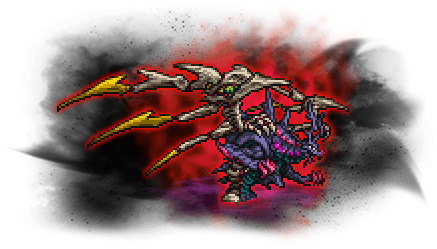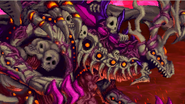
Chaos Bahamut, the True God of Destruction.
Chaos Bahamut (カオスバハムート, Kaosu Bahamūto?) is an antagonist that appears in Final Fantasy Dimensions II and serves as the physical form of the main antagonist of the Crystal of Time arc. It is a Chaos based on Mootie's God of Destruction form that Morrow and his friends encounter in the finale of the game's first arc.
Story[]
After Morrow and his friends restore the flow of time to all the eras in history after defeating all Four Chaoses with the power of the four crystals, it appears that a new future is finally on the horizon. However before the party can return to their eras, a time quake occurs and Atomos guides the party to the Day of Reckoning in 2026, despite their previous erasing the event from history earlier.
Returning to Navos Forest on the Day of Reckoning in 2026, the party is knocked down by a mysterious darkness attempting to rip apart space-time. Out of the darkness emerges Mootie's God of Destruction form revived despite the Day of Reckoning being prevented. Morrow is able to recognize that the creature is not Mootie and it is instead a different creature he names Chaos Bahamut, a form created by Chaos that mimics Mootie's God of Destruction form, being created from Chaos stealing Mootie's cells from past encounters. For the remainder of the game, Chaos uses this form as a physical form for itself, in an attempt to force the Day of the Reckoning to occur. The party attempt to fight the creature, however they are nearly destroyed by its Gigaflare attack, only to be saved in the nick of time by Atomos.

The party encountering Chaos Bahamut in the Chaos Torrent.
During the final episode, Morrow and his friends encounter Chaos Bahamut inside the Chaos Torrent. After defeating Chaos Bahamut the first time, Chaos Bahamut stops and appears to be defeated. However, it revives itself and becomes more powerful. In this new powerful form, it begins more disruptions in the different eras in history. Morrow and his friends fight the creature once again, but their attacks hardly damage the creature. After fighting the creature to no avail, Chaos Bahamut defeats Morrow and the party and revives the Four Chaoses in more powerful forms. However, due to the intervention of the spirit of Minwu, the party's allies from different eras are summoned to fight the Chaos versions of the Four Chaoses. Minwu then sends an Atomos Gate to allow Morrow and his friends to escape. Realizing that they cannot defeat Chaos Bahamut in its current form, Morrow and his friends travel through time to help their friends defeat the Chaoses.
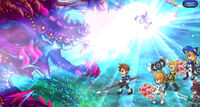
Mootie casting Megaflare on Chaos Bahamut.
After defeating the Four Chaoses once again, the party returns and attempt to defeat Chaos Bahamut once more; it disappears into a void, appearing the party has finally defeated it. However, Chaos Bahamut and the Chaoses revive once again and attempt to strike an unsuspecting Morrow, but Aemo pushes him out of the way and takes the fatal attack for him instead. The party escapes to find a way to heal Aemo.
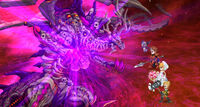
Neo Chaos Bahamut is defeated.
Being able to travel back in time to the point where Chaos Bahamut and the Chaoses attacked Aemo, Morrow, now aware of the events going to fold, pushes Aemo out of the way in time. Chaos Bahamut revives itself once again and Morrow and his friends are determined to fight the creature again. With the power of the Chaoses still empowering it, Chaos Bahamut still is unable to be defeated. However, Byakko, Suzaku, Seiryu, and Genbu sacrifice themselves to defeat the Four Chaoses. With the Four Holy Beast summons stopping the Chaoses from empowering Chaos Bahamut, Chaos Bahamut is now vulnerable to the party's attacks. Mootie begins to glow with a powerful light, which allows him to temporarily obtain the power of Bahamut and casts Megaflare on Chaos Bahamut. Morrow and the party fight Chaos Bahamut once again; however, defeating it this time allows it to transform into its most powerful form, Neo Chaos Bahamut. After a long and difficult battle, Chaos Bahamut is finally defeated once and for all.
Battle[]
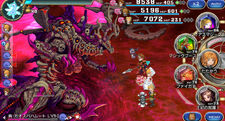
The party fighting Neo Chaos Bahamut.
Chaos Bahamut is fought multiple times throughout the game's final chapters. First as a scripted boss. During this fight, Chaos Bahamut cannot be defeated and will end the battle after five turns with Gigaflare.
Chaos Bahamut is fought again as the final boss in the "Day of Reckoning" battlefield of the Chaos Torrent as Neo Chaos Bahamut (真・カオスバハムート, Shin Kaosu Bahamūto?, lit. True Chaos Bahamut).
Summon[]

Chaos Bahamut's final artwork.
Chaos Bahamut is also a non-elemental summon. It can be obtained as a reward after completing the first battlefield for the "Versus Chaos Bahamut" event. The design for the summon's signets are based on Chaos Bahamut's appearances throughout the main story. Its rank five stone is based on the default appearance seen during the early chapters. The rank six stone's artwork is based on its appearance from when it is fought inside the Chaos Torrent. Its final artwork is based on its appearance as Neo Chaos Bahamut.
Chaos Bahamut's special attack is Magic Breaking Technique, which dispels beneficial status effects on all enemies and delays their next turn. All versions of Chaos Bahamut are able to go up to rank 8. Summoning Chaos Bahamut costs 2 point from the Consumption Gauge.
Depending on the summon's rank, characters that are equipped with Chaos Bahamut are able to use the following abilities:
- Judgment Day I
- Judgment Day II
- Judgment Day III
- Judgment Day IV
Chaos Bahamut's artwork was done by Akira Oguro.
- Stat Growth
| Rank | Maximum Level | Signet Cost | Max HP | Max MP | Max Attack | Max Magic | Max Speed | Components Needed |
|---|---|---|---|---|---|---|---|---|
| ★ 5 | 50 | 16 | 1973 | 78 | 142 | 77 | 73 | None |
| ★ 6 | 60 | 16 | 2420 | 96 | 173 | 97 | 90 | Components:
|
| ★ 7 | 70 | 16 | 2820 | 112 | 202 | 111 | 105 | Components:
|
| ★ 8 | 80 | 16 | 3308 | 140 | 238 | 131 | 121 | Components:
|
- Passive abilities
- The following are bonus abilities granted to characters equipped with Chaos Bahamut.
| Ability-type | Effects | Minimum activation rank |
|---|---|---|
| Judgment Day | 1 - 7% MP recovery for defeating an enemy | 5 |
Musical themes[]
Chaos Bahamut's theme is "God of Destruction, Bahamut" and was composed by Naoshi Mizuta. It is a prominent theme, as it plays during the scenes and boss encounters with Chaos Bahamut through the game. The theme is the tenth track on the official Final Fantasy Legends: Toki no Suishō soundtrack.
The final boss theme for Neo Chaos Bahamut is "All Space and Time, Shaking Decisive Battle" and was also composed by Naoshi Mizuta. The theme plays during the second and third rounds with Neo Chaos Bahamut. The theme is the thirty-sixth track on the official soundtrack.
Other appearances[]
Final Fantasy Record Keeper[]
Gallery[]
Etymology[]
Chaos refers to the void state preceding the creation of the universe in Greek creation myths, or to the initial "gap" created by the original separation of heaven and earth. Chaos also refers to a state of disorder, disharmony, dissonance, lawlessness, and unpredictability.
Bahamut (Arabic بهموت Bahamūt) originated as an enormous whale in ancient pre-Islamic Arabian mythology. Upon Bahamut's back stands a bull with four thousand eyes, ears, noses, mouths, tongues and feet called Kujuta (also spelled "Kuyutha") (compared with the pair of Behemoth and Leviathan). Between each of these is a distance of a 500-year journey. On the back of Kujuta is a mountain of ruby. Atop this mountain is an angel who carries six hells, earth, and seven heavens on its shoulders.
Another version of the Arabic story is that Bahamut is indeed a dragon and he stands on a whale called Liwash.
In modern times, the game Dungeons & Dragons is responsible for reimagining Bahamut as the king of dragons, a benevolent Platinum Dragon; the opposite of the malevolent Tiamat, the five-headed Chromatic Queen of Dragons.

